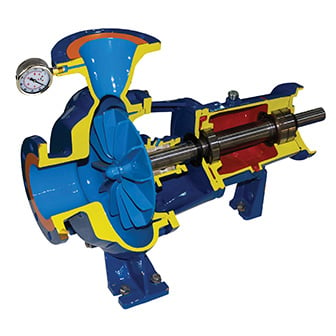There are many crucial elements in a pump that allow it to work effectively and reliably. Get to know the different pump parts and their importance to the overall performance and efficiency of your operations…
 Above: Inside a centrifugal pump
Above: Inside a centrifugal pump
Parts of a Centrifugal Pump
Casing: The casing is the shell, cover or a housing, which protects and supports the components. In pumps, the casing it a crucial component for preventing leakage and sometimes retain pressure. Sometimes it is referred to as the snail shell.
There are two types of pump casings, volutes and diffusers. Although there are different varieties, both are designed to take energy in the form of velocity and convert it into pressure.
Volutes: Designed to capture the velocity of the liquid as it enters the outermost diameter of the impeller.
Diffusers: Diffusers have multiple vanes and are positioned so they begin close to the outer edge of the impeller.
Impellers: This is the rotating component in a centrifugal pump which is equipped with vanes or blades which rotate and move fluid within the pump. These are a crucial component of the pump as it converts energy derived from a source.
There are two types of impellers available, axial flow impeller and radial flow impeller. In an axel flow impeller, the fluid moves axially to the shaft, and are commonly used for high flow and very low-flow pressure applications. Whilst in a radial flow impeller the fluid moves perpendicularly to the shaft and are used in multi-stage split case centrifugal pumps.
Impellers are also classified based on their suction type, single suction and double suction. In a single suction impeller, liquid enters from the centre of the blades from only one direction. Whereas in a double suction impeller the liquid enters the centre of the impeller blades from both sides simultaneously.
Seals: Mechanical Seals and Gland Packings act as a method of containing fluid within the pump. They are installed within the ‘seal area’ or ‘stuffing box’. Gland packing is a rope-like material cut into rings to wrap around the shaft sleeve. A mechanical seal allows the rotating shaft to pass through a stationary housing. It allows the rotating shaft to ensure the ‘wet’ area of the pump, without allowing fluid to escape.
Gasket: Gaskets are a sealing element used where parts requiring sealing are in contact with each other and do not perform a relative movement.
O-Ring Seal: O-Ring closes a gap between two surfaces so liquids and gases cannot pass through in any direction. It changes its shapes when pressure is applied in the system.
Bearings: The Bearing reduces friction on moving parts within the pump and supports the shaft to rotate smoothly. They are commonly found in all pump types. There are multiple types of bearings available, including:
- Roller bearings: use a cylindrical shape roller between moving parts. These reduce the friction and support radial and axial load.
- Ball Bearings use balls to support the movement of parts, although simple in design they are suitable for high speeds and are easy to maintain.
- Babbitt bearings are a type of sleeve bearing that is coated in Babbit metal - and are commonly used in motors, pumps, turbine generators and fans.
- Sleeve bearings: appropriate for high speeds, these bearings are ideal for radial loads only and are designed to float.
- Pivot Shoe bearings: also known as Tilt Shoe Bearings or Kingsbury Bearings are suitable for axial load and are installed in high powered centrifugal pumps as a thrust bearing
Bearing pedestal: The bearing pedestal is sometimes referred to as a block or pillow block and is used to provide support for the rotating shaft. It is generally constructed of cast iron or cast steel.
Pressure Gauges: An instrument used to measure and display pressure levels. It monitors the pump’s discharge or inlet pressure.
Oil Seals: It prevents leakage or entry of oil from a chamber, usually fit around a rotating or reciprocating shaft.
Our pump experts have over 40 years’ experience and know the importance of every pump component to the overall performance.
If you are looking for spare pump parts, or need some technical advice, contact our Global Pumps team.

